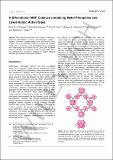Files in this item
Polyimide-cellulose interaction in Sb anode enables fast charging lithium-ion battery application
Item metadata
| dc.contributor.author | Wang, Shuo | |
| dc.contributor.author | Lee, Pui-Kit | |
| dc.contributor.author | Yang, Xuming | |
| dc.contributor.author | Rogach, Andrey L. | |
| dc.contributor.author | Armstrong, A. Robert | |
| dc.contributor.author | Yu, Denis Y. W. | |
| dc.date.accessioned | 2019-06-22T23:41:30Z | |
| dc.date.available | 2019-06-22T23:41:30Z | |
| dc.date.issued | 2018-09 | |
| dc.identifier | 253426007 | |
| dc.identifier | 38d0c935-fe5e-4201-ab50-b27fa0d0d6cd | |
| dc.identifier | 85048711868 | |
| dc.identifier | 000443217900026 | |
| dc.identifier.citation | Wang , S , Lee , P-K , Yang , X , Rogach , A L , Armstrong , A R & Yu , D Y W 2018 , ' Polyimide-cellulose interaction in Sb anode enables fast charging lithium-ion battery application ' , Materials Today Energy , vol. 9 , pp. 295-302 . https://doi.org/10.1016/j.mtener.2018.06.007 | en |
| dc.identifier.issn | 2468-6069 | |
| dc.identifier.other | RIS: urn:16789EC069E297AB5CB0C718EC33858B | |
| dc.identifier.other | ORCID: /0000-0003-1937-0936/work/46152037 | |
| dc.identifier.uri | https://hdl.handle.net/10023/17950 | |
| dc.description | The work described in this paper was supported by a General Research Fund (CityU 21202014) and the SFC/RGC Joint Research Scheme (X-CityU102/14) from the Research Grants Council of the Hong Kong Special Administrative Region, China and 2014_HK-Scot-0072 from the Scottish Funding Council. | en |
| dc.description.abstract | Antimony-based electrodes are promising as fast charging anodes for lithium-ion batteries because their operating potential is about 0.8 V vs. Li/Li+, far away from the plating potential of Li. However, their capacity decays fast due to large volume expansion, the issue which has often been addressed through the use of nano-sized materials. Herein, we utilize an ion-dipole interaction between polyimide and carboxymethyl cellulose which suppresses particle cracking and holds the particle together to enable antimony anodes utilizing micron-sized Sb particles for high rate applications. Sb anode with 9.4% polyimide coating exhibits a high reversible capacity of 580 mAh g−1 at 1 A g−1 with excellent cycle performance. The rate performance of the electrode can be further improved by adding 5% acetylene black during the polyimide coating process. Even at a current rate of 20 C (13.2 A g−1), a highly reversible capacity of 380 mAh g−1 can be obtained. The superior high-rate capability and excellent stability of Sb anodes are further verified by full-cell tests with LiFePO4 cathodes. | |
| dc.format.extent | 8 | |
| dc.format.extent | 2107097 | |
| dc.language.iso | eng | |
| dc.relation.ispartof | Materials Today Energy | en |
| dc.subject | Lithium-ion battery | en |
| dc.subject | Sb anode | en |
| dc.subject | Polyimide coating | en |
| dc.subject | Ion-dipole interaction | en |
| dc.subject | Fast charging | en |
| dc.subject | QD Chemistry | en |
| dc.subject | NDAS | en |
| dc.subject | SDG 7 - Affordable and Clean Energy | en |
| dc.subject.lcc | QD | en |
| dc.title | Polyimide-cellulose interaction in Sb anode enables fast charging lithium-ion battery application | en |
| dc.type | Journal article | en |
| dc.contributor.sponsor | Scottish Funding Council | en |
| dc.contributor.institution | University of St Andrews. School of Chemistry | en |
| dc.identifier.doi | https://doi.org/10.1016/j.mtener.2018.06.007 | |
| dc.description.status | Peer reviewed | en |
| dc.date.embargoedUntil | 2019-06-23 | |
| dc.identifier.grantnumber | 2014_HK-Scot-0072 | en |
This item appears in the following Collection(s)
Items in the St Andrews Research Repository are protected by copyright, with all rights reserved, unless otherwise indicated.

